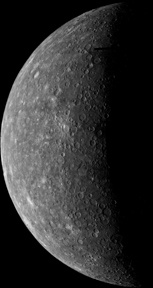 Size mattered,
astronomers say, when it came to whether or not material in our early solar
system stuck together to become today’s terrestrial planets — Mercury,
Venus, Earth and Mars. New models suggest that collisions between large objects
did not always result in those objects combining, as previously thought.
Size mattered,
astronomers say, when it came to whether or not material in our early solar
system stuck together to become today’s terrestrial planets — Mercury,
Venus, Earth and Mars. New models suggest that collisions between large objects
did not always result in those objects combining, as previously thought.The Mariner spacecraft captured this image of Mercury’s surface during a 1974 flyby of the planet. The diameter of Mercury is one-third the diameter of Earth, and some new models suggest that in its late stage of formation, the planet may have lost much of its mantle in an impact with a larger object. Image is courtesy of NASA.
Erik Asphaug, an astronomer at the University of California in Santa Cruz, suggests in the Jan. 12 Nature that in some large collisions, the smaller of the two objects escaped back into the solar system in what he calls a “hit and run” event — but not before the escaping body withstood violent deformation from the encounter. Such changes, Asphaug and colleagues say, might account for some of the unexplained compositions observed in local planets and asteroids.
Before the planets achieved their current sizes and orbits, hundreds of moon- and Mars-sized objects roamed the solar system, and over a period of 10 million to 100 million years, the objects occasionally crossed paths. In past models, researchers coded computer simulations to merge objects together at every collision, Asphaug says, but problems exist for that scenario. For example, if all objects that met were to have merged, the models show that planets would end up rotating so fast that any planet would “fling itself to death,” Asphaug says.
Asphaug does not contest the widely accepted theory that planets formed from accumulations of smaller planets. Direct hits, he says, would have stopped a planet “dead in its tracks,” and resulted in a merge. But direct hits between two large objects were likely “pretty rare,” he says, as most collided at angles. About half of all collisions probably allowed the smaller planet to escape, Asphaug says, although not without serious physical consequences.
To picture what a collision event would look like, Asphaug says to consider what a human sitting on Mars would see if a large rogue object struck Earth. A few hours before impact, Earth’s tidal forces would stretch the impactor into a football shape and then into a cigar shape. Those forces could tear off the impactor’s mantle, crust and atmosphere if it had one, and could also melt it, reshape it and even tear it to pieces, all in a matter of hours — severely altering the would-be planet or even reducing it to cosmic debris. Sudden pressure drops within the mantle of an impactor could also cause it to explosively shed its volatiles, or “de-gas,” which would explain the volcanic-like features found on many asteroids.
William Bottke, an astronomer at the Southwest Research Institute in Boulder, Colo., calls Asphaug’s model “intriguing,” and says that it may help answer specific questions about the asteroid belt — a region beyond Mars containing asteroids and debris that never formed into planets. Iron-rich asteroids that are abundant there, for example, could be the remnants of “failed planets,” impactors from which the mantle and crust were stripped, leaving mostly the iron core.
The process is not “100 percent efficient” at stripping bodies to their core, Bottke says. Asteroid 4 Vesta, for example, is a 500-kilometer “intact” asteroid in the asteroid belt (located between Mars and Jupiter), complete with a mantle and crust. Partial stripping might also account for Mercury’s thin mantle, if in fact it had been an impactor at some point in its history, Asphaug says.
Also, Asphaug’s model only applies to large bodies. Something tiny, like the 10-kilometer asteroid that struck earth 65 million years ago (and likely led to the extinction of the dinosaurs), will either directly impact a planet and stick, miss the planet entirely, or graze past it, he says. But for larger bodies, the model acts as a “recipe” for becoming more volatile-rich, and smaller planets becoming “more barren,” Asphaug says. “That’s what we see with Mercury and Mars.”
Researchers, Asphaug says, still need to look at debris stranded in the asteroid belt, where he says he thinks there should be “a solid record” for the hit and run model. Bottke agrees and says that Asphaug’s model for larger planets could be “readily incorporated” into his own research, which, published in the Feb. 16 Nature, suggests that small bodies now in the asteroid belt likely formed closer to the sun alongside the terrestrial planets. Both models together, Bottke says, “probably work in concert to produce just the right mix” of materials actually observed in the asteroid belt.

